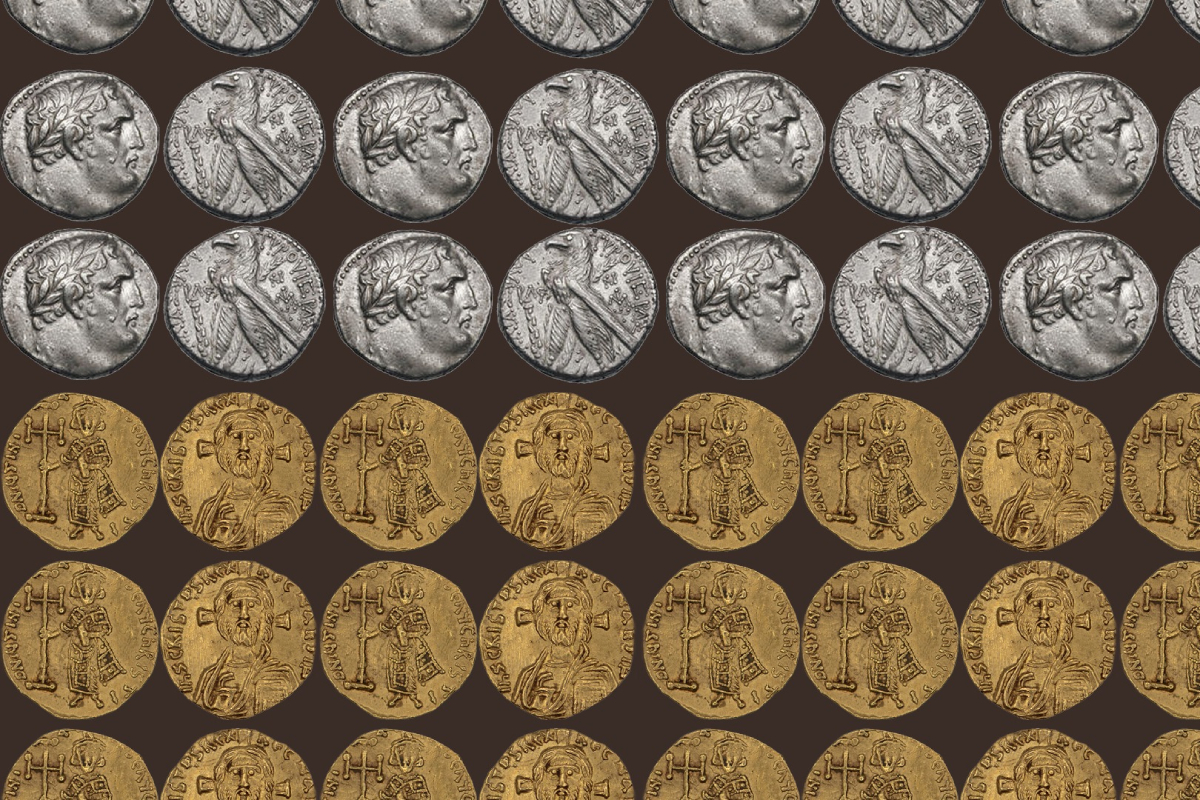
This is a two-part article on Jesus’ use of money, wherein I focus on a few texts and attempt to correlate Jesus’ teachings on money with his use of money. In this second part, we will see how Jesus used money for seeking the common good, paying taxes and charity.
TAX PAYMENTS
Every Jewish male had to pay a tax annually to the Jerusalem temple. This tax was levied towards the maintenance of the Temple. The temple tax collectors probably assumed Jesus disapproved of the tax due to his radical approach to religion.
However, Matthew records an instance where Jesus paid the temple tax (Matthew 17:24-27 and 22:15-22). It is reasonable to believe that Jesus regularly paid both the temple and the Imperial taxes.
In this instance, Jesus paid the temple tax for Peter and himself. Jesus instructed Peter to go to the sea, catch a fish (gk. ἰχθύς – Ichthus), find a coin (gk. στατῆρα statera) and pay the temple tax.
The four drachmae was the tax amount needed for two people.
Interestingly, this miracle is unique to Matthew’s Gospel (the interest probably was because he once served as a Tax collector).
Jesus performed the miracle of finding a coin (a less dramatic and unfamiliar miracle). Agreed, the miraculous supply is not the main focus of the story. However, we can glean the miraculous supply of money (at least in this instance) for payments.
The second incident, concerning the Roman tax, is found in Matthew 22:15-22. The question posed, “Is it lawful to pay taxes to Caesar or not?” (Matthew 22:17) was not innocent. The religious leaders were attempting to entrap him. The Roman coin bore “Tiberias Caesar, son of the divine Augustus”, which was considered blasphemous by the Jewish populace. Jesus’ affirmative answer would have as a traitor to the Jewish cause, and a negative response would have made him seditious if not an enemy of Rome.
Jesus says, “Give therefore to the emperor the things that are the Emperor’s and to God the things that are God’s.” Beyond the clever ambiguous response and rhetorical ruse, Jesus gives his hearers an important principle of fulfilling societal obligations. But more importantly, Giving “to God what is God’s” is a powerful reminder to focus on relationality with God. Elsewhere, Jesus chides his disciples for being angry with the (unnamed) woman for wasting perfume which cost a large sum of money.
“She has performed a good service… by pouring this ointment on my body, she has prepared me for burial”, he told his indignant disciples ( Mt 26: 6 – 13). Pastor Jeffery Curtis Poor writes, “ What Jesus is saying is if Caesar wants money, give it to him. It’s his anyway; his image is stamped on it. So, give him the temporary things he’s due. But don’t neglect God. While Caesar’s is temporary over the things of this world, God is over what’s eternal”.
JESUS AT THE TEMPLE
The Cleansing of the temple narrative ( Mt 21:12; Jn 2: 13 – 16) is the chasing of money changers profiting from exploitation. Those who visited the temple had to pay in Hebrew coins; therefore, they had to convert whatever money they brought into standard coinage (The Tyrian Shekel) for payment. The moneychangers profited because of the exaction of a conversion fee.
The selling of animals for sacrifices and the payment of the temple tax were permissible activities at the temple. However, in a symbolic act, Jesus turned over tables full of coins and chased away the animals.
Jesus did not favour the temple turning into a marketplace ( a possible allusion to Zech 14:21) as he wanted the temple to be a “house of prayer for all peoples”. Jesus did not wish the money changers to exploit the poor through excessive pricing and exaction of fees.
Note that Jesus focused on the money changers and those who sold doves – those who hurt the poor the most.
THE COMMON PURSE
The donations for ministry went into the common purse (Jn 13:29) under Judas’ care (Jn 12:6). The Jesus team used ‘the common purse’ to meet their expenses and possibly for almsgiving.
We glean this from the Johannine record of the last supper, wherein the disciples assume that Judas had gone to buy the needed things for the festival (Jn 13:29).
Jesus encouraged sharing amongst the disciples, and it is no surprise that the early church had all things in common (Acts 2:44). They even sold their possessions and distributed them to all, as any had need (Acts 2: 45).
GIVING TO THE POOR
Jesus (and the disciples) likely helped the poor and needy, which could have been a regular practice. The disciples quickly assume that Jesus had asked Judas to “ give something to the poor” (Jn 13:29)
Moreover, when a woman had anointed Jesus’ feet with expensive ointment, the disciples (Judas ?) exclaim: “ Why this waste? The ointment could have been sold for a large sum and given to the poor (Mt.26:9).
Jesus (and his disciples) must have given money to the poor and the needy from the (excess?) donations they received from their well-wishers. This is consistent with his teaching discouraging the storage of wealth (Lk 12: 33).
However, the distribution of one’s possessions was not general teaching. Jesus did not prescribe this teaching to all of his followers. As we have seen earlier, several of Jesus’ friends were affluent members of society. Zacchaeus’s promise to “give half his possessions to the poor” ( Lk 19:8) was also acceptable to Jesus.
True, in specific instances, Jesus did ask people to “sell their possessions and give it to the poor” (Mk 10:23). However, the principle here seems to be “freedom from the affections of the heart”.
In the narrative of the widow’s mite (Mk 12:41-44; Luke 21: 1 – 4), we learn that Jesus did not value the ‘amount’ While many rich people put in large sums, the widow put two mites (Greek lepta) into the treasury.
The lepta are the smallest Roman coins; yet, for Jesus, the widow’s contribution was more than all the others. He told the disciples that they have all contributed from their surplus wealth, but she, from her poverty, has contributed all she had, her whole livelihood.
For Jesus, what mattered the most was one’s attitude toward wealth and its use for social well-being. And this pretty much summarises Jesus’ teaching on money.
CONCLUSION
Jesus understood money as wages, as an investment, and a resource. His parables provide a window to his understanding of money in everyday life and what it does to those who possess it (and those who don’t). Jesus knew the importance of money in everyday life – (domestic affairs, business, travel and stay etc.).
Jesus did not despise the rich. However, he was against hoarding wealth beyond one’s needs, a lifestyle that does not care for the poor, and a carefree life that is insensitive to the needs of others. He also cautioned people regarding the machinations of money – greed, hoarding etc. and its tendency to become mammon (anti-God).
Jesus’ disciples were not to flaunt their generosity. On the contrary, they were to lead a life of humility, simplicity and charity. Jesus reverses the machination of money and encourages his disciples to be content, share their resources and grow rich towards God.
This is part 2 of the 2 part series titled “Did Jesus use money?“.







